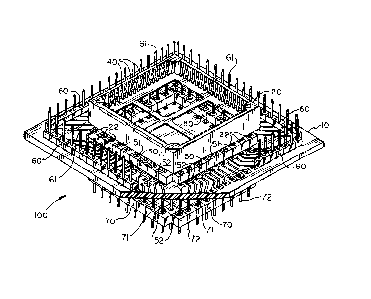Une partie des informations de ce site Web a été fournie par des sources externes. Le gouvernement du Canada n'assume aucune responsabilité concernant la précision, l'actualité ou la fiabilité des informations fournies par les sources externes. Les utilisateurs qui désirent employer cette information devraient consulter directement la source des informations. Le contenu fourni par les sources externes n'est pas assujetti aux exigences sur les langues officielles, la protection des renseignements personnels et l'accessibilité.
L'apparition de différences dans le texte et l'image des Revendications et de l'Abrégé dépend du moment auquel le document est publié. Les textes des Revendications et de l'Abrégé sont affichés :
| (12) Brevet: | (11) CA 1273130 |
|---|---|
| (21) Numéro de la demande: | 1273130 |
| (54) Titre français: | ADAPTATEUR DE SONDAGE POUR PRISE DE PORTE-PUCE |
| (54) Titre anglais: | TEST POINT ADAPTER FOR CHIP CARRIER SOCKETS |
| Statut: | Périmé et au-delà du délai pour l’annulation |
| (51) Classification internationale des brevets (CIB): |
|
|---|---|
| (72) Inventeurs : |
|
| (73) Titulaires : |
|
| (71) Demandeurs : |
|
| (74) Agent: | R. WILLIAM WRAY & ASSOCIATES |
| (74) Co-agent: | |
| (45) Délivré: | 1990-08-21 |
| (22) Date de dépôt: | 1987-06-15 |
| Licence disponible: | S.O. |
| Cédé au domaine public: | S.O. |
| (25) Langue des documents déposés: | Anglais |
| Traité de coopération en matière de brevets (PCT): | Non |
|---|
| (30) Données de priorité de la demande: | ||||||
|---|---|---|---|---|---|---|
|
TEST POINT ADAPTOR FOR CHIP CARRIER SOCKETS
ABSTRACT OF THE INVENTION
This arrangement provides for attaching test or probe
leads for such instruments as a logic analyzer to a leaded chip
carrier. This arrangement provides for terminating each chip
carrier lead to a metallic post upon which a logic probe or other
test apparatus may be mechanically attached to make electrical
connection. Since leaded chip carriers have their contact leads
closely spaced, this arrangement expands this distance between
leads to a suitable distance for connecting test probes. In this
manner, the semiconductor chip may be functionally tested as part
of a circuit on a printed wiring card.
Note : Les revendications sont présentées dans la langue officielle dans laquelle elles ont été soumises.
Note : Les descriptions sont présentées dans la langue officielle dans laquelle elles ont été soumises.

2024-08-01 : Dans le cadre de la transition vers les Brevets de nouvelle génération (BNG), la base de données sur les brevets canadiens (BDBC) contient désormais un Historique d'événement plus détaillé, qui reproduit le Journal des événements de notre nouvelle solution interne.
Veuillez noter que les événements débutant par « Inactive : » se réfèrent à des événements qui ne sont plus utilisés dans notre nouvelle solution interne.
Pour une meilleure compréhension de l'état de la demande ou brevet qui figure sur cette page, la rubrique Mise en garde , et les descriptions de Brevet , Historique d'événement , Taxes périodiques et Historique des paiements devraient être consultées.
| Description | Date |
|---|---|
| Inactive : CIB expirée | 2020-01-01 |
| Inactive : CIB désactivée | 2011-07-26 |
| Inactive : CIB de MCD | 2006-03-11 |
| Le délai pour l'annulation est expiré | 2003-08-21 |
| Lettre envoyée | 2002-08-21 |
| Accordé par délivrance | 1990-08-21 |
Il n'y a pas d'historique d'abandonnement
| Type de taxes | Anniversaire | Échéance | Date payée |
|---|---|---|---|
| TM (catégorie 1, 7e anniv.) - générale | 1997-08-21 | 1997-08-20 | |
| TM (catégorie 1, 8e anniv.) - générale | 1998-08-21 | 1998-08-13 | |
| TM (catégorie 1, 9e anniv.) - générale | 1999-08-23 | 1999-08-03 | |
| TM (catégorie 1, 10e anniv.) - générale | 2000-08-21 | 2000-08-21 | |
| TM (catégorie 1, 11e anniv.) - générale | 2001-08-21 | 2001-08-13 |
Les titulaires actuels et antérieures au dossier sont affichés en ordre alphabétique.
| Titulaires actuels au dossier |
|---|
| GTE COMMUNICATION SYSTEMS CORPORATION |
| Titulaires antérieures au dossier |
|---|
| DAVID ALAN KUTZ |
| ROBERT EDWARD RENNER |